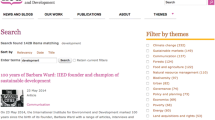Abstract
Literature review is an important but time-consuming task that involves many disparate steps. A simple query to a library database may return voluminous literature that often bewilders novices.We believe the bibliographic techniques developed by the information scientists provide useful process and methods that facilitate literature analysis and review. We thereby developed a citation-based literature analyzing and structuring system, which may facilitate novices to perform tasks that are usually carried out by trained professionals. A field study was carried out to gauge the utility as well as users’ perception using a questionnaire adopted from relevant empirical studies. Graduate students participated in the field study are able to publish papers in their first semester by utilizing this system. The utility and usefulness of the intellectual structuring system are demonstrated by the objective evidence of the high acceptance rate of papers utilizing the system as well as the subjective positive response from the users. A system utilization model utilizing the structure equation modeling technique found the task characteristics construct affects the information quality construct, which in turn affects the perceive usefulness of the system.






Similar content being viewed by others
References
Bagozzi, R. P., & Yi, Y. (1988). On the evaluation of structural equation models. Journal of the Academy of Marketing Science, 16(1), 74–94.
Batagelj, V., & Mrvar, A. (2003). Pajek Analysis and Visualization of Large Networks. In Graph Drawing : 9th International Symposium (Vol. 2265/2002, p. 477.) Lecture Notes in Computer Science. Berlin: Springer.
Bhattacherjee, A. (2001). Understanding information systems continuance: An expectation-confirmation model. MIS Quarterly, 25(3), 351–370.
Chen, C., & Steven, M. (2003). Visualizing evolving networks: Minimum spanning trees versus pathfinder networks. In IEEE symposium on information visualization (pp. 67–74).
Chen, T., & Xie, L. Identifying critical focuses in research domains. In 9th international conference on information visualisation (IV05), London, 2005 (pp. 135–142).Washington, DC: IEEE Computer Society. doi:10.1109/IV.2005.59.
Chou, S. W., & Liu, C. H. Learning Effectiveness in Web-Based Technology-Mediated Virtual Learning Environment. In System sciences, 2005. HICSS ‘05. Proceedings of the 38th annual Hawaii international conference on, 2005 (pp. 1–10) Los Angeles, CA: IEEE.
Christensen, E. W., Anakwe, U. P., & Kessler, E. H. (2001). Receptivity to distance learning: The effect of technology, reputation, constraints, and learning preferences. Journal of Research on Computing in Education, 33(3), 263–279.
Davis, F. D., Bagozzi, R. P., & Warshaw, P. R. (1989). User acceptance of computer technology: A comparison of two theoretical models. Management Science, 35(8), 982–1003.
DeLone, W. H., & McLean, E. R. (1992). Information systems success: The quest for the dependent variable. Information Systems Research, 3(1), 60–95.
Eccles, J. S., & Wigfield, A. (1995). In the mind of the actor: The structure of adolescents’ achievement task values and expectancy-related beliefs. Personality and Social Psychology Bulletin, 3(21), 215–225.
Garfield, E., Sher, I., & Torpie, R. (1964). The use of citation data in writing the history of science. Philadelphia, PA: Institute for Scientific Information.
Goodhue, D. L. (1995). Understanding user evaluations of information systems. Management Science, 41(12), 1827–1844.
Haynes, S. N., Richard, D., & Kubany, E. S. (1995). Content validity in psychological assessment: A functional approach to concepts and methods. Psychological Assessment, 7(3), 238–247.
Kleinberg, J. M. (1999). Authoritative sources in a hyperlinked environment. Journal of the ACM, 46(5), 604–632.
Lee, Y. W., Strong, D. M., Kahn, B. K., & Wang, R. Y. (2002). AIMQ: A methodology for information quality assessment. Information & Management, 40(2), 133–146.
Lin, J., & Lu, H. (2000). Towards an understanding of the behavioural intention to use a web site. International Journal of Information Management, 20(3), 197–208.
Nunnally, J. C. (1978). Psychometric theory. New York: McGraw-Hill.
Oliver, R., & Herrington, J. (2003). Exploring technology-mediated learning from a pedagogical perspective. Interactive Learning Environments, 11(2), 111–126.
Olsen, S. O. (2002). Comparative evaluation and the relationship between quality, satisfaction, and repurchase loyalty. Journal of the Academy of Marketing Science, 30(3), 240–249.
Page, L., Brin, S., Motwani, R., & Winograd, T. (1998). The page rank citation ranking: Bringing order to the web. Technical report, Stanford Digital Library Technologies Project.
Schvaneveldt, R. W. (1990). Pathfinder associative networks: Studies in knowledge organizations (Ablex series in computer science). Norwood, NJ: Ablex Pub. Corp.
Seddon, P. B. (1997). A respecification and extension of the DeLone and McLean model of IS success. Information Systems Research, 8(3), 240–253.
Seddon, P. B., & Kiew, M. Y. (2007). A partial test and development of DeLone and McLean’s model of IS success. Australasian Journal of Information Systems, 4(1), 117–148.
Small, H. (1973). Co-citation in the scientific literature: A new measure of the relationship between two documents. Journal of the American Society for Information Science, 24(4), 265–269.
Stevens, J. (2002). Applied multivariate statistics for the social sciences (4th ed.). Mahwah, NJ: Lawrence Erlbaum Associates.
Ullman, J. B., & Bentler, P. M. (2003). Structural equation modeling. In Handbook of psychology. New York, NY: Wiley.
Venkatesh, V., & Davis, F. D. (2000). A theoretical extension of the technology acceptance model: Four longitudinal field studies. Management Science, 46(2), 186–204.
Webster, J., & Watson, R. T. (2002). Analyzing the past to prepare for the future: Writing a literature review. Management Information Systems Quarterly, 26(2), 3.
White, H. D., & Griffith, B. C. (1981). Author cocitation: A literature measure of intellectual structure. Journal of the American Society for information Science, 32(3), 163–171.
Author information
Authors and Affiliations
Corresponding author
Rights and permissions
About this article
Cite this article
Chen, T.T. The development and empirical study of a literature review aiding system. Scientometrics 92, 105–116 (2012). https://doi.org/10.1007/s11192-012-0728-3
Received:
Published:
Issue Date:
DOI: https://doi.org/10.1007/s11192-012-0728-3




